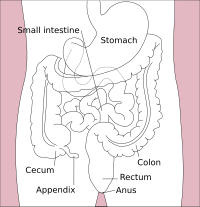
Photo from wikipedia
BACKGROUND & AIMS The homeostasis of the gastrointestinal epithelium relies on cell regeneration and differentiation into distinct lineages organised inside glands and crypts. Regeneration depends on WNT/β-Catenin pathway activation, but… Click to show full abstract
BACKGROUND & AIMS The homeostasis of the gastrointestinal epithelium relies on cell regeneration and differentiation into distinct lineages organised inside glands and crypts. Regeneration depends on WNT/β-Catenin pathway activation, but to understand homeostasis and its dysregulation in disease we need to identify the signalling microenvironment governing cell differentiation. By using gastric glands as a model, we have identified the signals inducing differentiation of surface mucus-, zymogen- and gastric acid- producing cells. METHODS We generated mucosoid cultures from the human stomach and exposed them to different growth factors to obtain cells with features of differentiated foveolar, chief and parietal cells. We localised the source of the growth factors in the tissue of origin. RESULTS We show that EGF is the major fate determinant distinguishing the surface and inner part of human gastric glands. In combination with BMP/NOGGIN signals, EGF controls the differentiation of foveolar cells vs. parietal or chief cells. We also show that EGF is likely to underlie alteration of the gastric mucosa in the pre-cancerous condition atrophic gastritis. CONCLUSIONS Use of our recently established mucosoid cultures in combination with analysis of the tissue-of-origin provided a robust strategy to understand differentiation and patterning of human tissue and allowed us to draw a new, detailed map of the signalling microenvironment in the human gastric glands.
Journal Title: Gastroenterology
Year Published: 2021
Link to full text (if available)
Share on Social Media: Sign Up to like & get
recommendations!